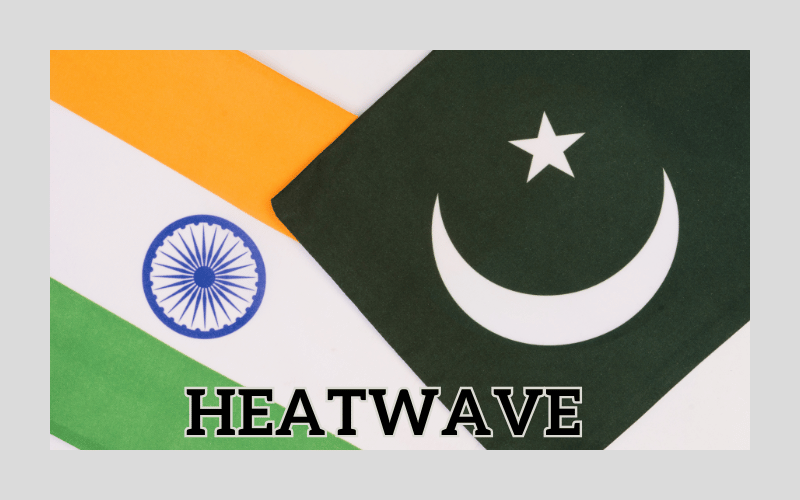People in India and Pakistan are facing one of the most dangerous and prolonged heat waves they have ever seen in 2025. Exceptionally high temperatures have resulted in problems for people, damaged systems, and have seriously put health at risk. The recent event shows how climate change is affecting the region more each day.
Unprecedented Temperature Surges
Temperatures in the region started rising 5-8°C higher than normal in the first days of April. New Delhi and Jaipur experienced temperatures higher than 40°C often this April, making normal life difficult and causing systems for both electricity and water to be completely stretched. The city of Barmer in Rajasthan saw a maximum temperature of 46.4°C on April 8, beating decades-old April high temperature records in the region.
In Balochistan, a region in southwestern Pakistan, temperatures rose to a record high of 48°C on May 1 in Sibi. Heatwave alerts were published by the Pakistan Meteorological Department, warning that temperatures could go as high as 7°C above usual because of a system in the upper air.
Humanitarian Impact
The severe heat waves have badly affected human health and livelihoods. Because of the heatwave in India, people are suffering from heat-related diseases, and communities doing farming in the northwest are experiencing many disruptions. Fieldworkers report that they sometimes become dehydrated, feel sick, and dizzy while working outside at peak temperatures. Just a few weeks before scheduled harvests, excessive heat damaged crops of mango, lychee, and wheat in Bihar.
Deadly windstorms have hit parts of Pakistan’s central and northern areas after the heatwave. Heavy winds left at least 14 people dead and around 100 more injured in Punjab and Khyber-Pakhtunkhwa after days of hot weather. They tore trees from the ground, brought down electric poles, and damaged the infrastructure a lot.
Infrastructure and Energy Strain
The rise in temperatures has caused a big jump in air conditioning use, which forces the power system in both nations to reach its limits. Loss of power for days in many regions has made the heat even worse for those dealing with this emergency. People living in Balochistan province sometimes get power cuts for up to 16 hours a day, and these interruptions keep essential cooling systems from working.
The road, railway, and waterway systems have also been harmed. Roads, rail lines, bridges, and railway and streetcar power cables are all damaged by excessive heat. The cold chain is often put at risk by problems with refrigeration equipment in trucks.
Climate Change Attribution
Climate researchers have connected the strength and quick arrival of the 2025 heatwave to changes brought by humans. Experts say that the conditions that brought on this heatwave are about 4°C warmer than those in the latter half of the 20th century. This means the March temperatures that have plagued South Asia were nearly five times as likely because of climate change, according to the Climate Shift Index by Climate Central.
According to the World Weather Attribution group, Kinshasa, Democratic Republic of the Congo, suffered so much from floods this month, largely because the city is highly vulnerable and has poor infrastructure planning. Unavailable data prevented scientists from fully understanding the part climate change played.
Government and Community Responses
In reaction to the rising crisis, governments and communities have begun a number of new projects. In Prayagraj and elsewhere across India, local officials have moved ahead with Heat Action Plans by painting roofs of slum homes, providing safe water, and making sure people understand the dangers of heat.
The government in Pakistan has announced heatwave alerts and is carefully following the changes. Pakistan’s weather department urges the public to prepare for more intense heat waves in the days ahead.
India’s Supreme Court has directed the Centre to respond to a request for stronger enforcement of heatwave plans, following the deaths of hundreds last year. The appeal requests that national heatwave action rules be followed and that money and support be offered to victims of severe heat.
Public Perception and Awareness
The results of a recent Yale Program on Climate Change Communication and CVoter survey indicate that more than half of adults in India are deeply worried about climate change. Recent analysis of 10,751 Indian residents indicated that many faced strong weather events the year before, including heatwaves (71%), problems with farming (60%), power outages (59%), and low water supply or pollution (over 50% each). More than half of the participants said they are ‘very concerned’ about heatwaves, droughts, pollution, problems with finding enough food, and the loss of biodiversity close to home. Besides, many Indians hold global warming responsible for rising environmental problems like those involving species, heat waves, and interrupted farming.

Investing in Heat-Resilient Infrastructure
It is clear from rising heat waves and climate change that India and Pakistan should prepare their infrastructure that withstand such changes. This includes:
- Covering rooftops with reflective paints helps lower indoor temperatures as much as 5°C. There have been successful attempts in Ahmedabad and Hyderabad, as government schemes in these cities now use such approaches to lower heat stress among slum residents.
- Raising more trees in urban spaces and planting shade over large public regions can make the city feel much cooler. Gardens on walls, rooftop farms, and green corridors in cities should be included in city planning rules.
- Polymer-modified asphalt in road construction reduces the chance of melting, particularly in Rajasthan and Sindh.
Strengthening Health Systems
- Public health is typically at the highest risk from heat waves. It is important that countries:
- Guide medical teams on how to handle and cure heatstroke, dehydration, and related heart problems resulting from high temperatures.
- Set up cooling services and emergency places to drink water when a heat alert is called, mainly for rural and undeveloped areas.
- Contribute to building systems that use weather and public service data to trigger alert messages and give medical assistance during heat waves.
Policy and Governance Reforms
- Governments need to treat improving heat resilience as a policy objective. Steps include:
- Taking steps to ensure every district and state develops Heat Action Plans (HAPs) that outline who is responsible, how they will react, and the budget allocated. As we head towards 2025, only some of the Indian states and Pakistani provinces have fully established HAPs.
- Amending the building codes to require natural cooling through ventilation, coverings over the facade, and heat-reflecting materials.
- Using climate funds to support efforts that help daily-wage workers, farmers, and the elderly adapt to heatwaves.
Regional Cooperation and Knowledge Sharing
- Since heatwaves and climate change problems impact the whole region, both countries might gain from working together.
- With shared meteorological data and combined models, heatwave prediction becomes more accurate across the countries in the Asian subcontinent.
- An alliance of governments under the South Asia Climate Resilience Forum could inspire best practices, act together during emergencies, and try to get more money for climate action from other nations.
Role of International Stakeholders
The whole world has something to do with tackling this issue. South Asia doesn’t cause much of the world’s carbon pollution, but it experiences greater climate effects than other parts of the world. Developed nations are required to:
- Ensure the pledge of $100 billion each year to developing countries, if carried out, contributes mainly to adaptation and mitigation measures.
- Allow people to use solar cooling and farming that can survive in any weather.
- Modify the rules for trade and help for development to ensure they don’t work against countries investing in climate adaptation.
Community Action and Public Awareness: The First Line of Defense
Both government actions and help from other countries help deal with heatwaves, but communities often do more by empowering people locally.
Many rural people in India and Pakistan are getting heatwave advice through WhatsApp groups, display boards in the market, and announcements at local gatherings. Interventions on a small scale are usually completed more rapidly and reach a more precise audience than global alerts.
In addition, traditional knowledge has significance. People living there have found that simple things like water-cooling clay pots and insulated mud homes help beat the heat at a low cost. NEWS: Government and NGO officials should find ways to include these approaches in overall public awareness efforts.
In addition, teaching about heat at school and college can encourage people to be ready for heat waves. Ensuring kids know what heatstroke looks like or encouraging them to find neighborhood “cooling clubs” that hand out water and shade during the hottest hours can help the community for a long time.
It’s especially important to tackle misinformation. Information for the public should challenge myths that being regularly exposed to heat is safe for young people and that drinking cold water helps with heatstroke. Messages from campaigns should be broadcast in both local languages and regional dialects by television, radio, and mobile alerts.
Ultimately, resilience is formed in the local community. Most importantly, awareness and the right tools help civilians react in emergencies so they can save someone’s life before the ambulance gets there.













